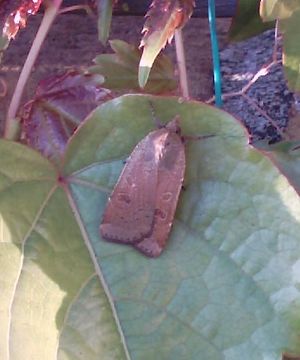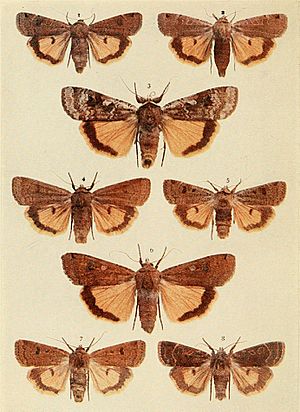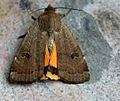Lesser yellow underwing facts for kids
Quick facts for kids Lesser yellow underwing |
|
|---|---|
 |
|
| Scientific classification |
The lesser yellow underwing (Noctua comes) is a type of moth that belongs to the Noctuidae family. It's known for its yellow hindwings, which are usually hidden when the moth is resting.
Where It Lives
You can find the lesser yellow underwing moth in many places around the world. It lives across Europe, North Africa, and parts of Asia, including the Middle East, Turkey, Iran, and even north-west India.
It has also traveled to new places. Around 1982, it was introduced to British Columbia in Canada and has since spread south in the Pacific Northwest region. It has also been seen in Ontario. This moth is quite common, but not as common as its larger cousin, the large yellow underwing moth.
What It Looks Like
The lesser yellow underwing moth looks a lot like a smaller version of the large yellow underwing moth. It has a wingspan of about 38 to 48 millimeters, which is roughly 1.5 to 1.9 inches.
Its front wings can be many different colors. They might be pale clay, reddish clay, light brown, or even almost black. The markings on these wings are usually dark and have a pale yellow outline. The wavy lines on the wings are faint. The hindwings, which are usually hidden, are a bright orange-yellow. They have a wide black band near the edge and a dark spot in the center. This central spot is usually missing in the large yellow underwing moth.
Life and Habits
This moth is active at night, flying from July to September. It is often attracted to lights and to the flowers of plants like heather, marram grass, and ragwort.
The larva, or caterpillar, of the lesser yellow underwing also looks very similar to that of the large yellow underwing. It can be green or brown and has black dashes along its back. However, these caterpillars eat differently. They don't cut plants at the base like some caterpillars do. Instead, they feed on the leaves of many different plants, trees, and shrubs. The lesser yellow underwing spends the winter as a larva.
What It Eats
The caterpillars of the lesser yellow underwing moth enjoy eating the leaves of many plants, including:
- Betula – birch trees
- Calluna – heather
- Cirsium – thistle plants
- Crataegus – hawthorn trees
- Digitalis – foxglove
- Fragaria – strawberry plants
- Plantago – plantain
- Prunus – blackthorn
- Rumex – docks and sorrel
- Salix – willow trees
Images for kids








